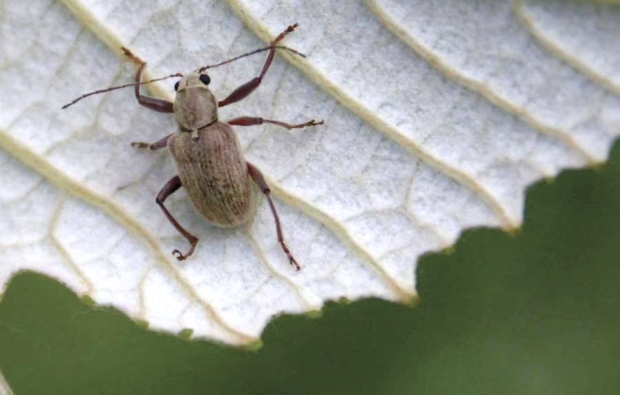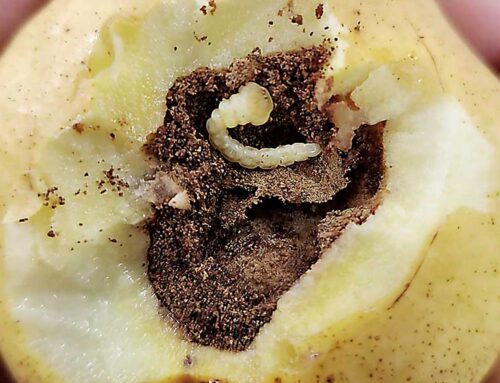
Although previously thought to emerge around July 4, adult rootworm beetles are emerging as early as June 21. One explanation may be Concord grapes bloom earlier than they did 20 years ago, and the insects have simply adapted to their food sources’ availability. (Courtesy Tim Weigle)
Concord grape growers in western New York and Pennsylvania are dealing with a pest they thought they had rid themselves of 25 years ago. But grape rootworm is back, and its adult beetle seems to be emerging a bit earlier.
Tim Weigle, New York state integrated pest management specialist and team leader of Cornell Cooperative Extension’s Lake Erie Regional Grape Program, said the insect was rediscovered on grapes being grown near Westfield, New York.
Most have been reported in Concord grapes since the vast majority of the region’s acreage is planted to that variety.
More recently, the pests are moving into other regions. “Now we’re seeing some in the Finger Lakes, primarily on native varieties, though we’ve had some reports of them on hybrids,” he said.
Biology
Females produce eggs three to seven days after mating, from early June through late July. Egg-laying peaks late from June through late July, but can continue into September.
Eggs are laid between cane and stem bark layers. Creamy yellow to white-colored eggs are oblong and found in clusters numbering from 20 to 100, hatching within 10 to 15 days.
Though they typically produce one generation a year, late-season hatches will result in larvae overwintering and emerging as adults the following year. As their name implies, the insects do most of their damage as larvae.
For the first nine to 10 months of their existence, the immature grubs will live in the soil, feeding on grapevine roots — eating smaller roots and boring into larger ones — then emerge as adults and feed on grape leaves. In heavy infestations, the bugs also have fed on immature grapes.
Damage to vines can result in loss of vigor and production in as few as three years.

Telltale chain patterns like these on Concord leaves are one of the ways scouts identify grape rootworm infestations. This kind of damage is minimal compared to the damage larvae do to roots. (Courtesy Tim Weigle)
During feeding, most larvae can be found in the top 12 inches of soil. In late fall, they move deeper into the soil to form cells in which they overwinter.
Traditional wisdom puts the best time to scout for adult rootworms’ emergence to be around July 4. In recent years, however, Weigle and his team have found them earlier; this year, they saw the first emergents on June 21, which has them asking why.
One explanation is the region has seen earlier bloom dates, which could explain the earlier emergence. “I wasn’t around then, but the scouts then may have just waited to look for them when feeding was obvious,” said Weigle.
They are still working on when first and peak emergence occurs and what factors influence it. “We’re fine-tuning how we scout for them so we can manage them more effectively,” he said.
Traditional controls
Once the pest emerges, adults can be found in the sucker growth, and then they’ll move up into the canopy.
That’s when control methods are most effective. “It’s the only way to go after them,” said Weigle.
Carbaryl is the only pesticide labeled for the pest. Last year, Weigle and Cornell University entomology professor Greg Loeb field-tested a number of other pesticides labeled for grapes to see if they, too, might be useful against the pest.
They identified four effective chemicals already labeled for use in grape production in New York: Admire Pro (imadacloprid), Leverage 360 (beta-cyfluthrin), Sniper (bifenthrin) and Danitol (fenpropathrin). Admire Pro and Sniper are not labeled for use in Alaska; Leverage 360 is not labeled for use in California; Danitol is registered for use in all 50 states.
None are labeled for grape rootworm, but Loeb applied to the U.S. Environmental Protection Agency to allow growers to use the products. The agency approved the applications, but usage requirements vary by state.
“By law, New York growers must have a copy of the FIFRA 2(ee) in their possession to use the pesticides, but Pennsylvania growers do not, as long as the product is labeled for grapes,” Weigle said.
Biocontrol research
Weigle is just starting a biocontrol investigation with Elson Shields, a Cornell University entomology professor. Shields has developed an entemopathogenic protocol — using insect-attacking, native nematodes.
Farmers raise and spray the nematodes onto their crops, then stand back and let them reproduce. So far, the protocol has picked off three pests — alfalfa snout beetles and two weevils preying on strawberries.
The alfalfa snout beetle’s feeding pattern is similar to that of the grape rootworm. Larvae burrow down into the soil to feed on alfalfa roots.
Though nematode application costs are well documented for forage crops, Weigle said researchers have yet to develop similar information for grapes.
“Dr. Shields has documented that since the nematodes we are using are native to New York, they can become established in the soil and do not require numerous reapplications,” he said.
For the last few weeks in June, Weigle was in western New York Concord vineyards collecting beetles, placing 2-by-2-foot catching frames with muslin stretched over them under the vines and shaking the top wire to catch adults.
He plans to release the captured adults onto caged potted vines. Then, he’ll apply three native New York nematodes to the vines in an attempt to gauge how effective they will be in eliminating grape rootworm larvae.
The three nematode species he will apply are all native to New York and supplied by Shields. The three nematode species are Steinernema carpocapsae, S. feltiae and Heterorhabditis bacteriophora and will be applied in three combinations, along with a control with no nematodes.
In a previous experiment in Japanese beetle control, Weigle, Loeb and Shields dribbled nematodes out through a boom sprayer with no pressure, using non-chlorinated water.
This time, since the vines are in pots, they’ll seed them with the wax-worm larvae used as nurseries to produce the nematodes.
Weigle said it would be two to three years before he has any reportable results. •
– by Dave Weinstock






Can anybody advise,
What is the cause of a wort like growth on the healthy end leaves of my grape vine. No visible sign of any bugs, the leaves are green on top but light brown indentations underneath. The wort size is about 3 mm deep and about 3/4 mm in diameter.
Mike